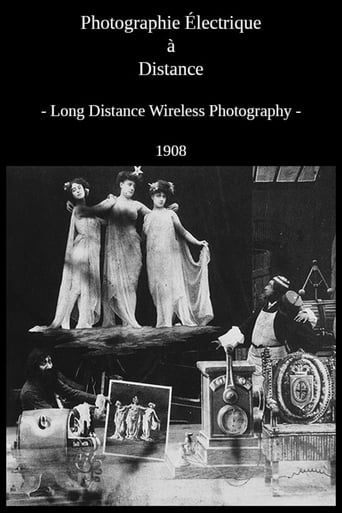

Melies is poking fun at the madness of science. In the process, his scientist has invented a type off camera that can send images through the air. An older couple show up to have their pictures taken. At first they get a demonstration of the new technology. Everything goes quite well. But when their turn comes, the pictures that arrive are venomous, showing the worst qualities of the people. This has a bit of a "Twilight Zone" sense to it. It is a bit boring but holds its own for quite a while. The machine is quite amazing.
... View MoreGeorges Méliès's was often at his best when lampooning contemporary scientific inventions, ideas and fiction—things that by today, if not by then, have become reality. He took man to the moon ("A Trip to the Moon", 1902), to the North Pole via a hodgepodge helicopter plane ("The Conquest of the Pole", 1912), undersea in a submarine ("Under the Seas", 1907), let them drive those newfangled automobiles ("An Adventurous Automobile Trip", 1905), terrorized them with Zeppelins ("The Inventor Crazybrains and His Wonderful Airship", 1907), took them just about everywhere in "The Impossible Voyage" (1904) and built a railroad tunnel through the English Channel ("Tunnelling the English Channel", 1907). In "Long Distance Wireless Photography" (which is a misleading translated title), Méliès demonstrated an intentionally-laughable invention for transmitting moving images to a screen—a kind of television.This is an otherwise routine single shot-scene trick film for Méliès, which can be generally amusing by itself, but I find the lampooning of science especially interesting here. Reportedly, there were already ideas around this time for television-like inventions. Allan Archibald Campbell-Swinton, for one, described a television method in the scientific journal "Nature" the same year that Méliès made this film. But, of course, no one had conjured quite as fantastical a version as the cinema magician did here.In the film, some supposed electric machinery is shown off before a photograph or painting of three women is used to produce moving pictures of those women on a screen. Next, a woman is photographed and her noticeably unsynchronized, superimposed self appears "live" on the black flat. Finally, "live" head close-ups of the elderly guests are projected. A knockabout finale is completed after the man's face is transmitted as some kind of grotesque monkey-looking clown. Thusly, this remote electromechanical TV system doesn't merely transmit and broadcast moving pictures, it does so with an image projector and has the ability to both create movement from still images and to mischievously transform and distort images.Méliès had previously made similar self-referential films "The Mysterious Portrait" (Le portrait mystérieux) (1899) and "The Magic Lantern" (La lanterne magique) (1903), which were also described in terms of media for still images, but the films obviously contained moving images within the outer moving images of the film proper. Whereas those films-within-films looked at the predecessors of motion pictures—photography and the magic lantern—this one looked to the future of motion pictures: television. Also unlike the two earlier films, this one doesn't only reveal movies' great trick to be reproducing life; the greatest trick is the ability to distort reality and invent something new.
... View MoreThis short silent film is part of the DVD collection entitled "The Magic of Méliès" and is the fourth volume of THE MOVIES BEGIN series from Kino Video. Unlike copies of Méliès' films that are posted on the internet, the prints for these short films are exceptionally crisp and clean and feature wonderful musical scores. Oddly, though, is that aside from a few films such as THE BLACK IMP and THE IMPOSSIBLE VOYAGE, most of the shorts chosen for this DVD are actually not among the best of Méliès' films--having a strong tendency to show is "stagy" material as opposed to the films that have elaborate sets and plots. In particular, my favorites such as BARBE-BLEUE and LE VOYAGE DANS LE LUNE (his most famous film) are not on this DVD.When the movie begins, the film seems a tad ordinary. However, as it progresses, the camera tricks become more and more impressive. And, to top off an already good film, the ending is very funny slapstick--with electrocutions and pratfalls galore. While not the director's best, this is a very good and about average film for Méliès.
... View MoreWhile it's a little less efficient than the best Méliès features, "Long Distance Wireless Photography" does have a couple of good moments in it. The fanciful story starts with a special camera that produces images which bring out hidden aspects or characteristics of its subjects. It takes a little while to set everything up before it really gets going, but along the way there are the trademark Méliès visual details and special effects. Except for a couple of high points, it's only mildly interesting by his standards, but of course that's not too bad by most other standards of the era.
... View More